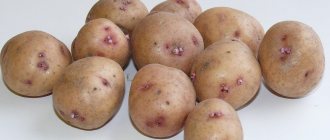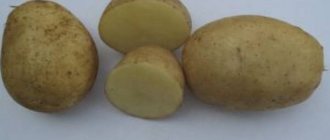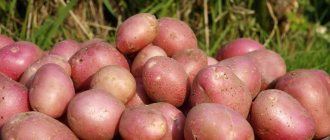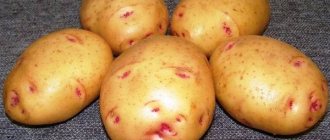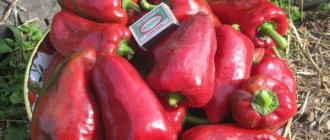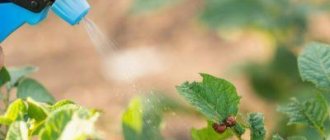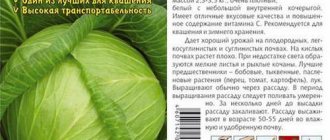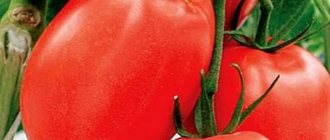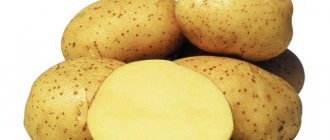Characteristics of the root crop
The tubers of the Yanka variety are uniform, very beautiful, and have the following characteristics:
- the shape of the root crop is elongated oval or round oval;
- weight of 1 potato from 80 to 106 g;
- peel slightly reticulate, medium-thin, yellow;
- the pulp is creamy, rich in vitamins, amino acids and protein;
- starch content up to 18%;
- there are few shallow, uncolored eyes.
Despite the moderate starch content, the potatoes cook poorly and become crumbly. The pulp does not darken during processing. Summer residents who grow Yanka potatoes characterize it as a very tasty variety suitable for sale. As for use in cooking and industry, it is suitable for almost all dishes and various types of processing.
Description of the plant
Bushes of the Yana variety grow up to 60cm. The stems are erect, but tend to partially bend. The shape of the stem is ribbed, and the color is green with yellowish tint. The bush produces many medium-sized, potato-type leaves. The color of the leaves is light green, matte. The lower part of the bush is often exposed when there is insufficient light.
The tops of each stem bear clusters of simple flowers. Their corollas are half fused and have a delicate white color. Pollination occurs naturally. The set berries may fall off completely. This property of the plant causes great damage during seed propagation of potatoes at breeding stations.
Each bush produces up to 12 tubers. At the stage of technical maturity, they are oval in shape and rich yellow in color. The potato skin is weakly mesh. Small depressions in which, over time, sprout eyes are almost invisible on the surface. They are small, white with pink continuation buds.
Advantages and disadvantages
The variety is good in all respects, but it is not particularly demanding in terms of cultivation and care. Let us highlight the main advantages of Yanka potatoes:
- high taste qualities;
- widely used in cooking;
- resistance to mechanical damage;
- attractive, marketable appearance of root crops;
- productivity;
- keeping quality;
- seed material does not degenerate;
- undemanding to soil composition;
- resistance to weather changes (slight cooling, showers and heat).
This Belarusian variety has practically no disadvantages; in the worst years or with improper care, it can exhibit weak immunity to some diseases.
You may be interested in: Dates for planting potatoes in May-June 2021 according to the lunar planting calendar Favorable days for planting potatoes in 2021 according to the lunar calendar Dates for planting potatoes in 2021 for central Russia and the Moscow region
Potato variety Yanka
Yanka is a Belarusian table potato variety (Solanum tuberosum) with a medium ripening period. Brought out by specialists from the Republican Unitary Enterprise “Scientific and Practical Center of the National Academy of Sciences of Belarus for Potato and Fruit and Vegetable Growing.” In 2012, it was included in the state register of breeding achievements of the Russian Federation. Approved for cultivation in two regions of the country: Northwestern and Central. It is successfully grown in other regions of Russia. It is distinguished by large tubers, high yield and resistance to many diseases. Suitable for growing both in garden plots and in large areas on an industrial scale. Suitable for mechanical cleaning.
The period from the appearance of full shoots to harvest is 90−100 days.
The plant is of medium height, leaf type, moderately spreading. The main stem is semi-erect. The leaves are medium in size, open, light green in color, with slight waviness visible along the edges of the leaf blade. The corollas are medium-sized, white, the intensity of the anthocyanin color on the inside is very weak or absent. Potatoes practically do not produce berries.
In one nest, 8-12 large homogeneous tubers with an average weight of about 81-106 grams are formed. They have an oval shape, a smooth surface without bumps. The peel is weakly mesh, strong, yellow in color. The pulp is white or light cream in color when cut. The eyes are small, uncolored, and their depth is average.
The marketable yield of the Yanka variety, according to the results of state tests, was recorded in the range of 195−311 c/ha, at the level of the Lugovskoy and Aurora standards. The largest amount was collected in the Kostroma region - 360 c/ha, 80 c/ha more than the results of Treasures. According to some reports, the yield indicator can reach up to 600 c/ha, but there is no confirmation of such results in official sources. The marketability of tubers is high - 85−95%, keeping quality is excellent - 96%.
The taste is very good, and according to reviews, even great! Tubers are characterized by medium digestibility and are universal in cooking. The pulp is moderately crumbly, of a pleasant consistency, not watery or dry. After heat treatment, the tubers do not darken or lose their shape, so they look very attractive when finished. These potatoes are great for frying, including deep-frying, boiling, stuffing, baking, and will be an excellent addition to soups and salads. The variety is also good for making purees, but it turns out not airy, “for everyone.” It is also suitable for industrial processing into chips, frozen semi-finished products and freeze-dried purees. The starch content in tubers is about 12.2−17.6%.
Yanka perfectly adapts to any soil and climatic conditions. However, the originator recommends growing it on light and medium-textured soils. Simply put, on sandy loams and light loams. But this does not mean that on other types of soil the yield will be noticeably lower; this largely depends on agricultural technology. The variety very actively uses nutrients and minerals from the soil, so in most cases it requires the application of increased doses of fertilizers, in particular mineral ones. Below are some other features of cultivation and care.
- Before planting, it is necessary to select and calibrate the seed material. Small specimens without mechanical damage or signs of disease are best suited. Due to the high resistance of this variety to many diseases, it is not necessary to pickle the tubers. But treatment with growth stimulants can be beneficial.
- Planting is carried out in early to mid-May, when the soil warms up to +8−10°C and the danger of frost has completely passed.
- The originator of the variety provides recommendations on planting density. For cultivation in order to obtain marketable products, 45−48 thousand tubers per hectare are planted, and in order to obtain seed material, 52−55 thousand tubers per hectare should be planted.
- As already mentioned, plants are very responsive to feeding. You shouldn’t feel sorry for mineral complexes, but it’s better to be on your guard with nitrogen complexes - a large number of them leads to increased growth of tops to the detriment of tubers.
- As for watering potatoes, this activity should be carried out as necessary. Do not allow the soil to become too dry or waterlogged; this will have a painful effect on the plants. In northern latitudes, for example, watering may not be required at all.
- Also, do not forget about standard agricultural practices; they can significantly influence the yield. These include timely loosening of the soil, weeding, hilling, as well as treating plantings with insecticides. According to gardeners, Yanka is very fond of the Colorado potato beetle, so preventive measures should not be neglected.
- Maintain crop rotation on your property. This is very important, even though our hero is resistant to many nightshade diseases. The most profitable predecessors are legumes, onions, cucumbers, cabbage, garlic, beets, and green manure.
- Renew seed material in a timely manner. Thanks to this event, your harvest will always remain at the proper level, the tubers will not become smaller and lose their presentation.
The variety is highly resistant to the golden cyst nematode, the causative agent of cancer, wrinkled and striped mosaic, and leaf curl virus. It exhibits average resistance to common scab, blackleg, Alternaria, fusarium dry rot, anthracnose, late blight of tubers and tops.
In a relatively short period of existence, Yanka managed to win the trust of gardeners in many parts of Russia and Belarus. It is especially valued for its high yield, excellent presentation of tubers and their delicious taste, disease resistance, ease of care and ability to adapt to any growing conditions. They also note its excellent keeping quality: potatoes can be stored for more than a year without losing their consumer qualities and pleasant appearance. Another advantage is its resistance to mechanical damage, which makes harvesting possible by machine.
Among the disadvantages, mention should be made of the demands on the mineral composition of the soil. To obtain high yields, you will have to take care of providing the plants with fertilizers. It is also necessary to say that our hero, although he has a wide distribution area, is rather poorly zoned in some regions, for example the Ural, Siberian, etc. With proper agricultural technology, of course, this problem can be solved, but if you are not a sufficiently experienced gardener, then It is better to choose some other variety that is well adapted to growing in your area.
In a short time, Yanka gained quite a lot of popularity in the wide potato market, showing excellent results both in state tests on experimental plots and in amateur cultivation on personal plots. Our hero is distinguished by reliability and stability, which cannot always be said about many other varieties on the market.
Features of cultivation
Yanka is one of the few potato varieties that can take root and bear fruit well in any soil, but do not forget that the crop is much more comfortable in fertile, loose soils. Experienced gardeners advise not to neglect fertilizing and watering; potatoes will reward you for your care with a high, high-quality harvest. Recommendations for planting Yanka potatoes:
- pre-prepared material should be planted (sprouted and disinfected with Fitosporin), cutting potatoes is not recommended, the weight of the tuber should be from 30 to 90 g;
- planting is carried out in heated (from mid-May), loosened soil without weeds;
- distance between holes 30–35 cm, row spacing 70 cm, hole depth 10 cm;
- the best predecessors for potatoes are legumes, corn, meadow grasses, carrots or cabbage;
planting is carried out not only on a flat surface; trench and nesting methods are also suitable. Planting in ridges or ridges is acceptable.
Potatoes need watering when planting, 2 weeks after green shoots appear, during bud formation and flowering. If it rains during any of these periods, there is no need for additional irrigation of the beds. To avoid evaporation of moisture, the beds are mulched; this procedure is especially useful for opponents of hilling. If digging in autumn and spring is accompanied by the application of fertilizers, it will be enough to pour a little ash and organic matter into the holes when planting. In cases where the soil is depleted, attention should be paid to the potato beds when tops appear, during budding and flowering. Organic and mineral complexes are suitable. The last time you can feed the bushes leaf by leaf 10 days before harvest, with a superphosphate solution. Hilling is carried out in standard terms - the first time 2 weeks after emergence, the second another week later, and the last time before the tops close.
Correct fit
Rules for planting the “Yanka” variety:
- Despite the undemanding nature of the soil, greater yields can be achieved when grown on fertile soil. The area for planting is prepared in the fall. The soil is being dug up. In the spring, re-digging is carried out, plant residues and weeds are removed;
HELP: Choose well-lit areas.
- Seed material is planted using nesting or trench method;
- Before planting, seed tubers are carefully selected. Reject specimens with traces of infection and damage. Plant the planting material in well-warmed soil;
- Humus and wood ash are added to the planting holes.
Diseases and pests
According to the originator of the Yanka variety, it has good immunity to potato nematode, cancer and viral diseases (when cultivated in fields). Resistance to diseases such as scab, black leg, late blight, fusarium dry rot, alternaria and anthracnose is average. Gardeners note that the variety is not affected by wrinkled, striped mosaic and leaf curl virus. Treating tubers and soil before planting serves as a preventative measure for many diseases, and coupled with proper planting and care, it is quite possible to do without therapeutic sprays. To control pests, folk recipes or industrial insecticides are used.
Collection and storage
Yanka potatoes reach technical maturity from the moment of planting in 90 or 110 days, it all depends on the region and climatic conditions. The dense skin protects the root crops from damage during digging, which greatly simplifies the process of preparing the crop for storage. The variety has excellent keeping quality (up to 96%), in a cool place the harvested crop will last until the next season without losing its marketable qualities. Janka potatoes are often grown for sale. The totality of the advantages of the variety suggests that it will be popular for many years to come. Yanka potatoes practically do not get sick and do not degenerate, which means that planting material can be collected independently. Potatoes are very tasty, versatile in use and store well.
Origin
The Yanka potato variety was bred by Belarusian breeders . Originator: Belarusian Center for Vegetable and Plant Growing. The variety was included in the State Register of the Russian Federation in 2012. Potatoes are zoned for the Central and Northwestern regions. Recommended for cultivation in industrial fields and farms, cultivation in personal gardens is possible. The harvested crop is perfectly stored and suitable for transportation. Smooth, neat tubers are ideal for sale; they can be packed directly on the field.
Reviews
Anna. I like Yanka because it is slightly overcooked, but everyone has their own preferences. I’ve recently grown this variety, and what can I say, the harvest is good, the potatoes are tasty, and they last a long time. I didn’t find any signs of disease, but last year there was an invasion of the Colorado potato beetle, which I successfully fought with Aktara.
Yana. I knew nothing about the Yanka variety until 2015. I bought some very tasty potatoes at the market, found out the name and managed to plant them that same year. Now I want to say thank you to the breeders of Belarus for the most favorite variety in my collection; before that, the Skarb potato was in the lead. Yanka is an undemanding and productive variety with good immunity.
